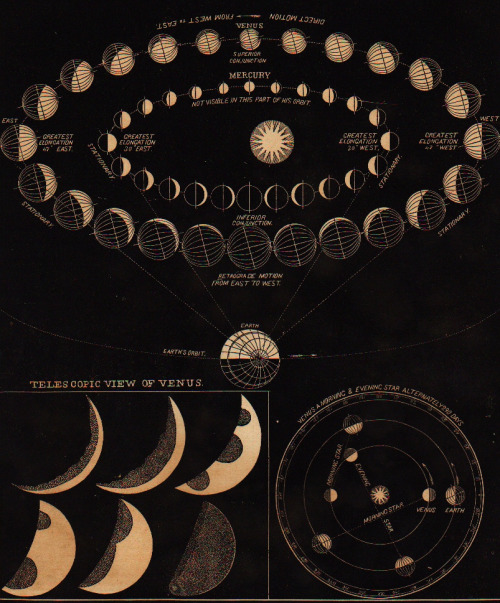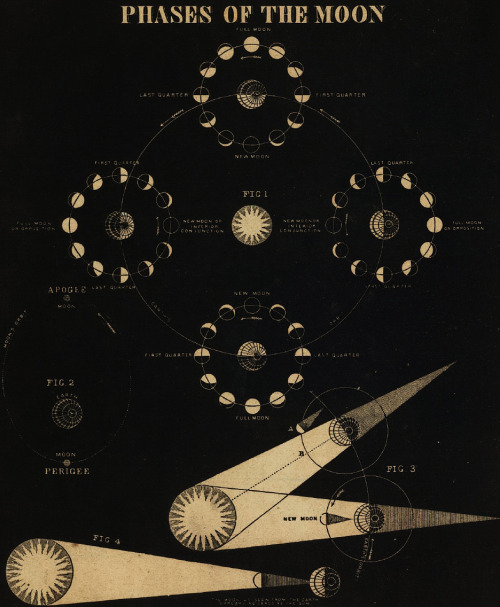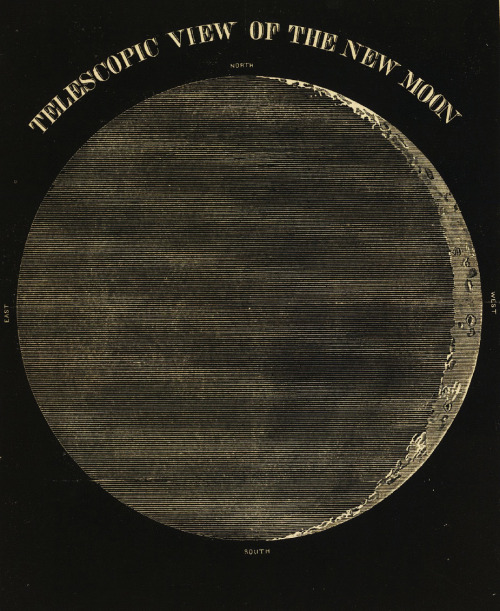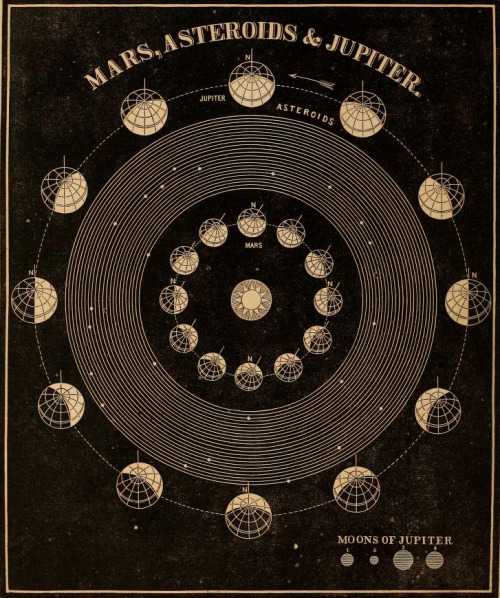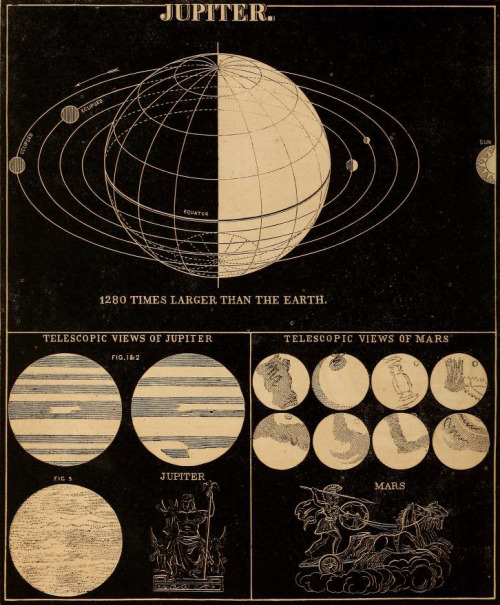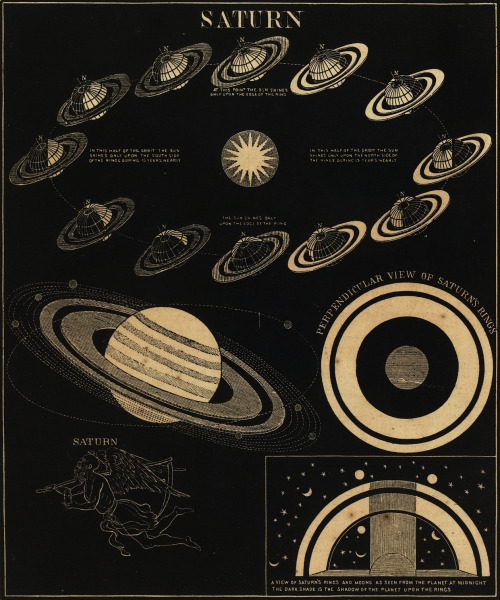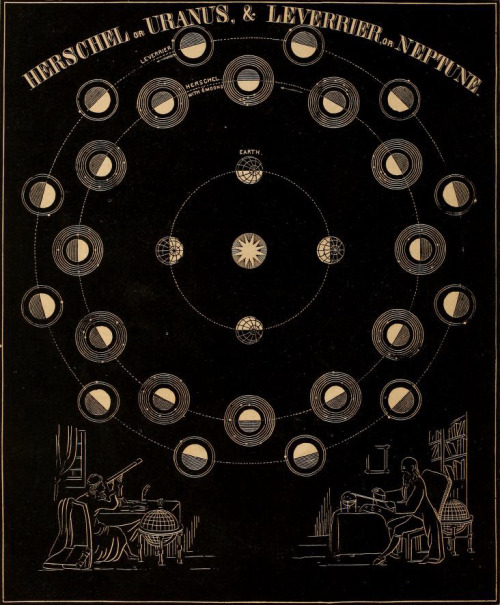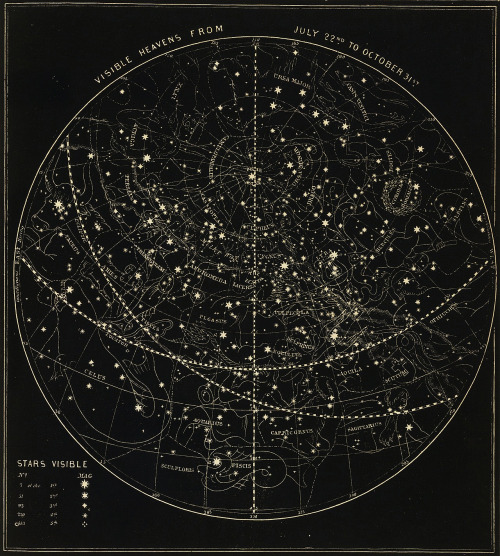Its Pretty Incredible How Accurate The Science Of Astrophysics Has Gotten. New Horizons Actually Arrived
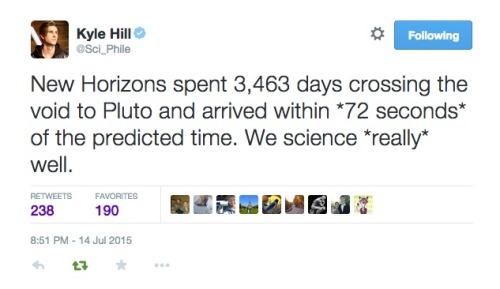
Its pretty incredible how accurate the science of astrophysics has gotten. New Horizons actually arrived 72 seconds early after travelling for almost 10 years straight to its destination.
More Posts from Fillthevoid-with-space and Others

Why Star Trek matters.

Why do the Sun and Moon move the way they do? What’s up with that? Orbits? What? It’s a short but snug little episode here about the Sun and the Moon and how they look from Earth as they zoom across the sky.
Below the cut are my sources, music credits, a vocab list, the transcript of this episode, a composite image of the different phases of the Moon, and a list of the different names for the full moons through the course of a year. Let me know what you think I should research next by messaging me here, tweeting at me at @HDandtheVoid, or asking me to my face if you know me in real life. And please subscribe to the podcast on iTunes, rate it or review it, and maybe tell your friends about it if you think they’d like to listen!
(My thoughts on the next episode, because I still haven’t found the time to cover them, are the Voyager golden records, space race history, the transit of Venus, the Moon landing, or Edmond Halley. Let me know by the 6th and I’ll hopefully have the next podcast up on October 16th.)
Glossary
blue moon - when you get two full moons in one calendar month. An older definition is when you get 4 full moons in a season, the third moon is called the ‘blue moon.’
ecliptic - the path of the Sun over the course of a year.
prograde - when a planet spins from east to west.
retrograde - when a planet spins from west to east.
spaghettification - when extreme tidal forces pull an object apart in space.
Script/Transcript
Sources
Rising and setting times of the Sun on Earth via Cornell University
Seasons on Earth via Cornell University
Lunar phases and the Moon’s relationship to the Sun via Harvard
Tides via Hyperphysics
Tidal forces equation via AstronomyOnline.org
Tidal forces and spaghettification via NASA handout
Lunar phases composite via Fred Espenak
Names of the different full moons throughout the year via EarthSky.org
Blue moons via EarthSky.org
Intro Music: ‘Better Times Will Come’ by No Luck Club off their album Prosperity
Filler Music: ‘See The Constellation’ by They Might Be Giants off their album Apollo 18
Outro Music: ‘Fields of Russia’ by Mutefish off their album On Draught
What was the hardest part in training to go to space?
One of the most challenging parts of space training was learning how to use the space suit. We weigh over 400 pounds in the space suit, and since it is pressurized, each movement of your hands is like working against an exercise ball. Since the suit needs to be quite bulky in order to protect us from the environment of space (vacuum, radiation, micrometeoroids, extreme temperature) while doing a spacewalk, it makes body movements a bit awkward. Dexterity is quite compromised with the bulky gloves as well. Although it is challenging, however, it is likely also the most rewarding, because, well, you are in a SPACE SUIT!!! Hopefully I’ll get to do a spacewalk and look down on the our planet from above on a mission to the International Space Station in a few years.

In the Heart of the Virgo Cluster : The Virgo Cluster of Galaxies is the closest cluster of galaxies to our Milky Way Galaxy. The Virgo Cluster is so close that it spans more than 5 degrees on the sky - about 10 times the angle made by a full Moon. With its heart lying about 70 million light years distant, the Virgo Cluster is the nearest cluster of galaxies, contains over 2,000 galaxies, and has a noticeable gravitational pull on the galaxies of the Local Group of Galaxies surrounding our Milky Way Galaxy. The cluster contains not only galaxies filled with stars but also gas so hot it glows in X-rays. Motions of galaxies in and around clusters indicate that they contain more dark matter than any visible matter we can see. Pictured above, the heart of the Virgo Cluster includes bright Messier galaxies such as Markarians Eyes on the upper left, M86 just to the upper right of center, M84 on the far right, as well as spiral galaxy NGC 4388 at the bottom right. via NASA
js
Raising the bar for antimatter exploration
CERN - European Organization for Nuclear Research logo. March 18, 2017 The absence of antimatter in the universe is a long-standing jigsaw puzzle in physics. Many experiments have been exploring this question by finding asymmetries between particles and their antimatter counterparts. GBAR (Gravitational Behaviour of Antihydrogen at Rest), a new experiment at CERN, is preparing to explore one aspect of this puzzle – what is the effect of gravity on antimatter? While theories exist as to whether antimatter will behave like matter or not, a definitive experimental result is still missing.
Image above: Installation of the GBAR linac in its shielding bunker. The electrons accelerated to 10 MeV toward a target will produce the positrons that are necessary to form antihydrogen with the antiprotons coming from the ELENA decelerator. (Image: Max Brice/CERN). GBAR will measure the effect of gravity on antihydrogen atoms. Located in the Antiproton Decelerator (AD) hall, GBAR is the first of five experiments that will be connected to the new ELENA deceleration ring. On 1 March, the first component of the experiment was installed – a linear accelerator (linac). In sharp contrast to the LHC’s chain of big accelerators and fast particles, the AD world of antimatter is small and its particles are as slow as they come. The GBAR linac is only 1.2 metres long and it will be used to create positrons, the antimatter equivalent of electrons. The experiment will use antiprotons supplied by ELENA and positrons created by the linac to produce antihydrogen ions. They consist of one antiproton and two positrons, and their positive charge makes them significantly easier to manipulate. With the help of lasers, their velocity will be reduced to half a metre per second. This will allow them to be directed to a fixed point. Then, trapped by an electric field, one of their positrons will be removed with a laser, which will make them neutral again. The only force acting on them at this point will be gravity and they will be free to make a 20-centimetre fall, during which researchers will observe their behaviour. The results might turn out to be very exciting. As the spokesperson of GBAR, Patrice Pérez, explains: “Einstein’s Equivalence Principle states that the trajectory of a particle is independent of its composition and internal structure when it is only submitted to gravitational forces. If we find out that gravity has a different effect on antimatter, this would mean that we still have a lot to learn about the universe.” Five other experiments are based at the Antiproton Decelerator, two of which – AEGIS and ALPHA – are also studying the effect of gravity on antimatter. Note: CERN, the European Organization for Nuclear Research, is one of the world’s largest and most respected centres for scientific research. Its business is fundamental physics, finding out what the Universe is made of and how it works. At CERN, the world’s largest and most complex scientific instruments are used to study the basic constituents of matter — the fundamental particles. By studying what happens when these particles collide, physicists learn about the laws of Nature. The instruments used at CERN are particle accelerators and detectors. Accelerators boost beams of particles to high energies before they are made to collide with each other or with stationary targets. Detectors observe and record the results of these collisions. Founded in 1954, the CERN Laboratory sits astride the Franco–Swiss border near Geneva. It was one of Europe’s first joint ventures and now has 22 Member States. Related links: GBAR (Gravitational Behaviour of Antihydrogen at Rest): https://gbar.web.cern.ch/GBAR/public/index.html Antiproton Decelerator (AD): https://home.cern/about/accelerators/antiproton-decelerator ELENA: http://home.cern/about/updates/2016/11/new-ring-slow-down-antimatter linear accelerator (linac): http://home.cern/tags/linear-accelerator AEGIS: http://home.cern/about/experiments/aegis ALPHA: https://home.cern/about/experiments/alpha For more information about European Organization for Nuclear Research (CERN), Visit: http://home.cern/ Image (mentioned), Text, Credits: CERN/Iva Raynova. Greetings, Orbiter.ch Full article

New Zealand was lovely, but I already touched on what I’d be tempted to talk about with my Southern Stars episode. A person I interviewed as a potential new housemate gave me the idea for this episode because the joy of outer space is truly everywhere and anywhere. The field of astrogeology was not something I had heard of before, though I had indirectly heard of Eugene Shoemaker. I knew the comet Shoemaker-Levy 9 was named after him (and Carolyn Shoemaker, his wife). It turns out he basically founded the modern field of astrogeology! So I talk about him for quite a while, too.
Below the cut are the glossary, transcript, sources, and music credits. Send me any topic suggestions via Tumblr message (you don’t need an account to do this, just submit as anonymous). You can also tweet at me on Twitter at @HDandtheVoid, or you can ask me to my face if you know me in real life. Subscribe on iTunes to get the new episodes of my semi-monthly podcast, and please please please rate and review it. Go ahead and tell friends if you think they’d like to hear it, too!
(The next episode is definitely going to be on famous comets, and I’m hoping to publish that episode in May.)
Glossary
active galaxy - a galaxy with a small core of emission embedded at the center. This core is typically very variable and very bright compared to the rest of the galaxy. These galaxies emit much more energy than they should; this excess energy is found in the infrared, radio, UV, and X-ray regions of the electromagnetic spectrum.
black hole - a region of spacetime where a great deal of mass and energy have been compressed into a relatively small space. Black holes exert such strong gravitational effects that no mass or energy, not even light, can escape from inside them. There are supermassive black holes in galaxies that contribute to the development and life cycle of galaxies.
blazar - a subcategory of active galaxy, it is an extremely bright, distant object, powered by a black hole, which emits massive amounts of energy. It is distinct from a quasar because it is even brighter.
interferometry - a group of techniques to extract information from superimposing electromagnetic waves to create interference. In radio astronomy, this is done by using a wide spread of receivers to look at the same distant object, then bringing that data together with a correlator that can create a larger, clearer picture than an individual radio telescope alone could.
Messier object - a deep-sky object included on a list of 103-110 deep-sky objects made by Charles Messier and his colleagues in the 18th century in an attempt to prevent fuzzy, bright objects from being confused with comets.
torus - a donut shape.
quasar - a distant, massive celestial object that emits extremely large amounts of energy. These star-like objects may reflect a stage in the evolution of some galaxies.
Script/Transcript
Sources
Black Holes, explained via National Geographic
What Is a Black Hole? via NASA
Black Holes via NASA
Black Hole via Swinburne University of Technology
Darkness Visible, Finally: Astronomers Capture First Ever Image of a Black Hole via the New York Times (April 2019)
Event Horizon Telescope
Astronomers Capture First Image of a Black Hole via ESO (April 2019)
How They Took the First Picture of a Black Hole via New York Times (April 2019)
Intro Music: ‘Better Times Will Come’ by No Luck Club off their album Prosperity
Filler Music: ‘Flame On Flame (A Slow Dirge)’ by Kishi Bashi off his album Sonderlust
Outro Music: ‘Fields of Russia’ by Mutefish off their album On Draught
If Earth had Saturn’s Rings
From an excellent post by Jason Davis
From Washington, D.C., the rings would only fill a portion of the sky, but appear striking nonetheless. Here, we see them at sunrise.

From Guatemala, only 14 degrees above the equator, the rings would begin to stretch across the horizon. Their reflected light would make the moon much brighter.

From Earth’s equator, Saturn’s rings would be viewed edge-on, appearing as a thin, bright line bisecting the sky.

At the March and September equinoxes, the Sun would be positioned directly over the rings, casting a dramatic shadow at the equator.

At midnight at the Tropic of Capricorn, which sits at 23 degrees south latitude, the Earth casts a shadow over the middle of the rings, while the outer portions remain lit.

via x
NASA’s Hybrid Computer Enables Raven’s Autonomous Rendezvous Capability
ISS - International Space Station patch. March 21, 2017 A hybrid computing system developed at NASA’s Goddard Space Flight Center in Greenbelt, Maryland, is the enabling technology behind an ambitious experiment testing a relative navigation and autonomous docking capability known as Raven.
Image above: This panorama of the International Space Station was composed by piecing together images taken by Raven’s Visible Camera. These images were processed by a hybrid computing platform, SpaceCube 2.0. Image Credit: NASA. Developed by the Satellite Servicing Projects Division, or SSPD, the carry-on luggage-sized module was launched February 19 aboard SpaceX’s Dragon spacecraft, along with other experiments deployed outside the International Space Station on an experiment pallet. Raven is testing and maturing visible, infrared and lidar sensors and machine-vision algorithms; the module will bring NASA one step closer to realizing the groundbreaking autopilot capability that can be applied to many NASA missions for decades to come. Since NASA’s pre-Apollo days, the agency has successfully docked spacecraft while they speed through space. However, all operations involved humans who orchestrated the movements from the ground. Raven’s objective is to develop and mature technologies that ultimately will relieve human dependency and give spacecraft the ability to catch up with one another and dock autonomously in real time. “The Raven module is equipped with technology that lays the foundation for a relative navigation system,” said Goddard Director Christopher Scolese. “What some may not fully appreciate is the fact that Raven’s sensors could not do their job if it weren’t for another very effective technology called SpaceCube. The SpaceCube processor is the behind-the-scenes technology that is making this important demonstration possible.” SpaceCube is a reconfigurable, very fast flight computing platform that Goddard technologists first demonstrated during a relative navigation experiment on the Hubble Servicing Mission-4 in 2009. During the Raven experiment, the module’s “sensors serve as the eyes. SpaceCube acts as the brain, analyzing data and telling components what to do,” said Ben Reed, deputy division director of SSPD. The “eyes” and the “brain” together create the autopilot capability. Since its initial development, SpaceCube has evolved into a family of flight computers all distinguished by their computing speed, which is 10 to 100 times faster than the commonly used spaceflight processor — the RAD750. Though the RAD750 is immune to the adverse effects of radiation, it is slow and many generations behind the computing speed of commercial processors. SpaceCube processors achieve their data-crunching prowess because Goddard technologists married radiation-tolerant integrated circuits, which are programmed to execute specific computing jobs simultaneously, with algorithms that detect and fix radiation-induced upsets in collected data. Consequently, these hybrid systems are nearly as reliable as the RAD750, yet orders-of-magnitude faster, capable of executing complex computations once limited to ground-based systems.
Image above: This image shows the Defense Department’s experiment pallet, STP-H5, hanging at the end of Canada’s robotic arm during installation on the outside of the International Space Station. Image Credit: NASA. During its two-year stay on the space station, Raven will sense incoming and outgoing visiting space station spacecraft, feeding the data it “sees” to SpaceCube 2.0, one in the family of SpaceCube products. SpaceCube then runs a set of pose algorithms, or a set of instructions, to gauge the relative distance between Raven and the spacecraft it is tracking. Then, based on these calculations, SpaceCube 2.0 autonomously sends commands that swivel the Raven module on its gimbal or pointing system to keep the sensors trained on the vehicle, while continuing to track it. While all this is transpiring, NASA operators on the ground monitor Raven’s technologies, paying close attention to how they function as a system and making necessary adjustments to increase Raven’s tracking abilities. “Tracking spacecraft with this system is only possible because we have SpaceCube,” said SSPD Avionics Technology Lead and SpaceCube Lead Engineer David Petrick, who has won prestigious awards for his work on the processor. “This type of operation requires fast computing.” Raven’s foundational technologies will be applied to future missions. For example, Restore-L, which also will use SpaceCube 2.0, will rendezvous with, grasp, refuel and relocate Landsat 7 when it launches in 2020. SpaceCube 2.0, however, isn’t the only processor now at work on the space station’s external experiment pallet sponsored by the Department of Defense’s Space Technology Program. SpaceCube 1.0 is being used as the communication interface between the space station’s data services and multiple experiments on the pallet. In addition, a miniaturized version of SpaceCube 2.0 — the SpaceCube Mini — is operating two NASA and U.S. Defense Department experiments. NASA also is testing two other miniature computers, developed with the University of Florida. These models are mostly equipped with commercial parts. For other technology news, go to https://gsfctechnology.gsfc.nasa.gov/newsletter/Current.pdf Related links: Raven: https://sspd.gsfc.nasa.gov/Raven.html SpaceCube: https://spacecube.gsfc.nasa.gov/ Space Station Research and Technology: https://www.nasa.gov/mission_pages/station/research/index.html International Space Station (ISS): https://www.nasa.gov/mission_pages/station/main/index.html Images (mentioned), Text, Credits: NASA Goddard Space Flight Center/Lori Keesey/Lynn Jenner. Greetings, Orbiter.ch Full article
-
 londonadayatatime liked this · 2 months ago
londonadayatatime liked this · 2 months ago -
 tremendousdreamtragedy reblogged this · 8 months ago
tremendousdreamtragedy reblogged this · 8 months ago -
 bythelightofmylaptop liked this · 1 year ago
bythelightofmylaptop liked this · 1 year ago -
 nukedrobotchris liked this · 1 year ago
nukedrobotchris liked this · 1 year ago -
 nukedrobotchris reblogged this · 1 year ago
nukedrobotchris reblogged this · 1 year ago -
 lolidkw liked this · 1 year ago
lolidkw liked this · 1 year ago -
 hedgehog18 reblogged this · 1 year ago
hedgehog18 reblogged this · 1 year ago -
 summersong2262 liked this · 2 years ago
summersong2262 liked this · 2 years ago -
 libresbian liked this · 2 years ago
libresbian liked this · 2 years ago -
 samuraikingkyo reblogged this · 2 years ago
samuraikingkyo reblogged this · 2 years ago -
 samuraikingkyo liked this · 2 years ago
samuraikingkyo liked this · 2 years ago -
 aroseofjericho reblogged this · 2 years ago
aroseofjericho reblogged this · 2 years ago -
 jenjensd reblogged this · 2 years ago
jenjensd reblogged this · 2 years ago -
 jenjensd liked this · 2 years ago
jenjensd liked this · 2 years ago -
 bunnnyhannny liked this · 2 years ago
bunnnyhannny liked this · 2 years ago -
 master7mindd reblogged this · 2 years ago
master7mindd reblogged this · 2 years ago -
 ebztheebz liked this · 2 years ago
ebztheebz liked this · 2 years ago -
 ebztheebz reblogged this · 2 years ago
ebztheebz reblogged this · 2 years ago -
 ghoulishlybighomo reblogged this · 2 years ago
ghoulishlybighomo reblogged this · 2 years ago -
 ghoulishlybighomo liked this · 2 years ago
ghoulishlybighomo liked this · 2 years ago -
 lillysocks liked this · 2 years ago
lillysocks liked this · 2 years ago -
 violethyacinth reblogged this · 2 years ago
violethyacinth reblogged this · 2 years ago -
 darlingkeepmydreamsasecret liked this · 2 years ago
darlingkeepmydreamsasecret liked this · 2 years ago -
 riseofthewolf liked this · 2 years ago
riseofthewolf liked this · 2 years ago -
 feelingtyche reblogged this · 2 years ago
feelingtyche reblogged this · 2 years ago -
 blueneptuune reblogged this · 2 years ago
blueneptuune reblogged this · 2 years ago -
 blueneptuune liked this · 2 years ago
blueneptuune liked this · 2 years ago -
 twotwentyfiveam liked this · 2 years ago
twotwentyfiveam liked this · 2 years ago -
 holyfunnyhistoryherring liked this · 2 years ago
holyfunnyhistoryherring liked this · 2 years ago -
 asthoughtobreathewerelife liked this · 2 years ago
asthoughtobreathewerelife liked this · 2 years ago -
 moongalleon22 reblogged this · 2 years ago
moongalleon22 reblogged this · 2 years ago -
 adultingrefs reblogged this · 2 years ago
adultingrefs reblogged this · 2 years ago -
 ilikecatsandchips liked this · 2 years ago
ilikecatsandchips liked this · 2 years ago -
 kyn19 liked this · 2 years ago
kyn19 liked this · 2 years ago -
 interdimensional-chaos liked this · 2 years ago
interdimensional-chaos liked this · 2 years ago -
 burnt-kloverfield reblogged this · 2 years ago
burnt-kloverfield reblogged this · 2 years ago -
 mikirugg liked this · 2 years ago
mikirugg liked this · 2 years ago -
 urlocalllama liked this · 2 years ago
urlocalllama liked this · 2 years ago -
 stripedshirtgay reblogged this · 2 years ago
stripedshirtgay reblogged this · 2 years ago
A podcast project to fill the space in my heart and my time that used to be filled with academic research. In 2018, that space gets filled with... MORE SPACE! Cheerfully researched, painstakingly edited, informal as hell, definitely worth everyone's time.
243 posts


